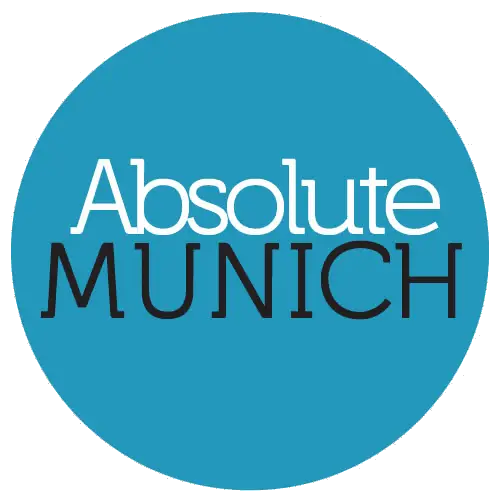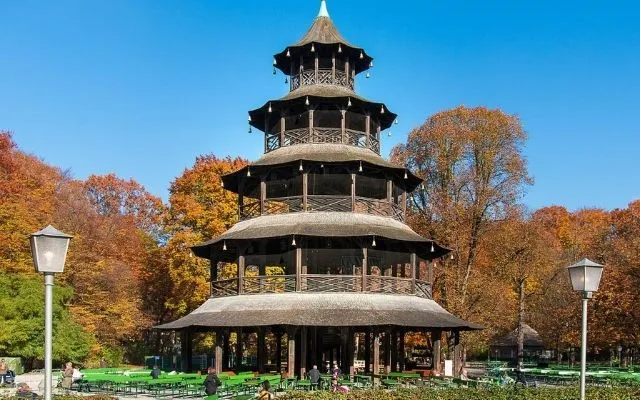Why not take a short break from German & Bavarian Culture and enjoy a relaxing visit to the very different, and totally unique Chinese Tower Munich, located bang in the middle of the English Gardens.
The Chinesischer Turm (Chinese Tower in German) is a unique, far-east cultural attraction, that whilst being somewhat out of place compared to the traditional Munich Touristic Sights, is nevertheless, strangely suited to its location.
The construction’s history and heritage give it appeal and adds to its charm and magic, making the Chinese Tower well worth a visit when you’re in Munich.
This article will totally inform you of all the ins and outs of visiting the Chinese Tower Munich so you won’t miss a beat when you’re there.
We hope you enjoy the read!
Where is the Chinese Tower In Munich?
The Munich Chinese Tower is located in the very heart of the English Gardens in Munich, and it’s actually considered one of the garden’s “signature” landmarks.
Surrounded by the wonderful 7000-seat beer garden, this is a sought-after hospitality destination here in Munich, especially for the younger crowd, particularly in the summer when the area can be heaving.
This is a very popular meeting place for Munich residents and tourists alike and almost anyone in the city will know of its location.
History of the Munich Chinese Tower
The History of the Chinese Tower is certainly colourful and adds to the overall attraction of the building.
Originally built on the very spot it sits today, the Munich Chinese Tower was constructed in 1789 during the creation of the Englischer Garten.
Local German carpenters studied Chinese architecture extensively to recreate its beauty for the German residents. The Munich Chinese Tower’s inspiration came from the 50-meter-high London Great Pagoda that’s found in Kew Gardens in the UK capital.
Sadly the original Chinese Tower was destroyed during bombings in World War II in 1944, but fortunately, thanks to generous donations and the fortitude of a group of people, the tower was reconstructed in 1952 to match its former glory.
Though the Munich Chinese Tower was originally an observation deck, it is no longer suitable for this goal since many of the trees surrounding it have grown taller than the tower’s observation decks themselves.
Instead, the newly rebuilt tower is now largely a landmark, and many events are hosted around the tower. A small number of people are occasionally allowed access, but this is limited to no more than fifteen at a time.
Architecture of the Munich Chinese Tower
The Munich Chinese Tower is a pagoda-like construction, 25-meters in height, and crafted fully from wood.
The tower is incredibly unique, and it features powerful Chinese themes in its architectural design.
The main architectural style of the Munich Chinese Tower is Chinoiserie, which is characterised as being a European interpretation of traditional Asian and Chinese traditions.
Nevertheless, though not an original Chinese design itself, this stunning pagoda is certainly one that’s rich with Chinese themes and culture overall.
Events at the Chinesischer Turm
While the Munich Chinese Tower doesn’t often hold large events within its observation decks exclusively anymore, there are many events hosted around the Chinesischer Turm.
For example, live music is often played during public holidays or on Sundays from a band on the circular decks. One of Munich’s Most unique festivals is also held here on the third Sunday every July. The Kocherlballis is a traditional Munich Dance Festival derived from events in the 19th century when upwards of 5,000 Munich servants would meet here on a Saturday to dance and laugh the morning away.
The Chinese Tower also hosts an annual Christmas Market for anyone visiting Munich during the festive period.
Munich Chinese Tower Restaurant and Beer Garden
One of the main attractions of the Chinese Tower Munich nowadays is the Chinesischer Turm Beer Garden (and the nearby Chinesischer Turm Restaurant).
Both of these attractions are found near the Chinese Tower, offering a stunning backdrop with truly delicious dining opportunities and chances to relax with a Stein of Beer (Maß Bier), perhaps enjoyed with some traditional Bavarian Brotzeit or Pretzel as any tourist would call it.
Most of the seating around the Chinese Tower is self-service so you must go up to the vendors and purchase your food and drink options before returning to your seat. There is a small services section of about 500 seats also.
Make sure to try some traditional beer garden food such as Steckerlfisch (grilled fish on a stick), the Roast Chicken Hendl (roasted chicken), or the very tasty Bavarian Roasted Knuckle of Pork (Schweinshaxn).
What to do Nearby the Munich Chinese Tower
There’s a lot to love around the Munich Chinese Tower and for most people, simply exploring the wider park is probably one of the most significant attractions in the area.
Especially popular in the warmer months there are opportunities for hiking, cycling and even surfing to be enjoyed nearby.
Aside from the Munich Chinese Tower’s famous (or infamous) beer garden and restaurant, you could equally find other fabulous bier garten and eateries nearby such as the SEEHAUS im Englischen Garten (The Lake House) or perhaps the Mini-Hofbräuhaus further to the north deeper into the gardens.
Just outside of the confines of the English Gardens you’ll discover some of Munich’s amazing tourist locations such as the Siegestor, the Munich Residenz, the Alte Pinakothek, Munich’s Hofgarten, and much more.
You can easily spend an entire day in the English Gardens and nearby.
The Chinesischer Turm München: Don’t Miss it
If you love socialising and you equally love food and drink, then this is a place that should certainly be on your Munich Radar.
The Chinese Tower here in the English Gardens of Munich offers so much more than just a place to meet or eat, and we’re confident that if you visit, you’ll discover your own unforgettable memories here.
We hope you enjoyed the article and as always, we’d love to hear from you – just drop us an email via our contacts page.
Prost – Cheers

